President Wohlpart responds in wake of Title IX protests
 Katherine Camarata Lead Editor
Katherine Camarata Lead Editor
dents regarding the handling of Title IX cases are taking place.
“There’s a whole range of ways that we reach out,” Wohlpart said. “I’ve talked with faculty and staff, sometimes it’s a hallway conversa tion, sometimes it’s after a meeting; sometimes it’s an email.”
Wohlpart characterized these conversations generally, and said: “Folks have said that they appreciate the direction we’re going, the trans parency, that we have had the will ingness to take all of this work very seriously, to recognize that perhaps in the past we have not done things as well as we might have.”
“We are absolutely committed to going in the right direction,” Wohl part said, adding that these conver sations will eventually channel into the Gender-Based Violence Pre vention workgroups announced via email (see side story). According to Wohlpart, the workgroups, also referred to as committees, will set the groundwork for the university to investigate their policies, proce dures and practices.
“Those committees really will be charged with thinking about how they will investigate best practices, learn about what we have done and then make a series of recommendations, so I’m really going to try and turn it over to them.”
Wohlpart said he asked for nominations for the workgroups from shared governance leaders by the end of November and will continue communicating about these efforts in early December.
The Observer request ed access to report or sit in on the workgroup meet ings, however Wohlpart said he believes this would affect the committee’s willingness to authentically discuss certain topics.
Wohlpart mentioned major shifts coming up at CWU as a result of the reauthorization of the Vio lence Against Women Act, changes in the Clery Act and shifts in Title IX implemented by the Biden Ad ministration.
According to a White House press release, the reauthorization of the Violence Against Women Act is supposed to involve “increasing services and support for survivors from underserved and marginal ized communities. Specifically, the LGBTQ+ communities, survivors of domestic violence, dating vio lence, sexual harassment, stalking, funding survivor-centered com
munity-based restorative practice services and increasing support for culturally specific services.”
Wohlpart suggested that Trump reduced the individuals protected by Title IX, while Biden is seeking to expand this coverage again.
“The Trump final rules were characterized as being less amena ble to victims and more amenable to the alleged perpetrator,” Wohl part said. “I think the Biden admin istration will shift that back, to give more rights back to the victims.”
“There’s more expansive embrace of different groups than has existed in the past,” he added.
When asked how he intends to support these shifts going forward, Wohlpart said it would require a change in culture which needs to happen from the bottom-up as op posed to only top-down.
“The reason that I’m taking this through shared governance is that what we need to do is not just check boxes, but change the culture,” Wohlpart said. “The way you change the culture is not by deciding things top down, but by making sure that the universi ty community comes together to learn about this … so that it be comes part of our practice. Long term, I want this to be sustainable. I want to make sure that this exists way beyond me.”
According to Wohlpart, it is im portant for CWU to approach in vestigations in a “trauma-informed” manner.
“Being trauma-informed is one of the hardest pieces, because un less you’re the person who has been traumatized in that kind of way, you don’t necessarily know what that feels like or looks like,” Wohl part said. “The question is always how do you completely investigate in a way that is objective, but that also recognizes the trauma?”
Cats Against Assault, owners of the Instagram account and group of advocates, has organized two campus protests this fall concern ing alleged mishandling of Title IX cases on campus (see “Cats Against Assault offers updates about cam pus response.”) Wohlpart has not attended these protests.
Wohlpart said he was present at protests in spring demanding a Multicultural Center, but that stu dents politely told him they did not want him to be part of the demon strations.
“I said, ‘I agree with your effort here. I’m on your side, but I recog nize that you want space,’” Wohl part explained. “So, I am giving stu dents space when they do protests.”

Cats Against Assault responds to actions of administration
Second campus protest held
The Observer spoke exclu sively to representatives from the Cats Against Assault (CAA) team, who have asked to con tinue to stay anonymous for fear of retaliation from perpe trators and administration.
The CAA team claimed peo ple on campus have accused them of lying since creating their Instagram account. De spite this backlash, the team said they have higher expecta tions beyond what they’ve al ready achieved.
“We’re happy that there’s a response and that’s definite ly a result of the protests and all this student and communi ty involvement,” a CAA team representative said. “However, it’s not a concrete response and there’s no real timeline to it.”
The CAA team said they hope victims of Title IX cases will have a say in future policy reformation. They said despite the support they’ve received, they worry people will become prematurely relaxed. They expressed concern that com munications from President Wohlpart have “made it seem like he was doing more than he actually is.”
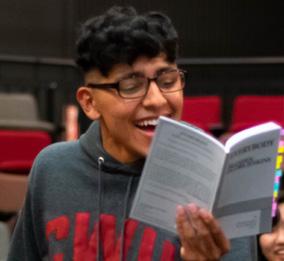

Cats Against Assault held a first campus protest on Nov. 3 and a second on Nov. 21 from 11 a.m. - 2 p.m. with groups of up to 25 making rounds from the SURC around Samuelson Hall and back past Black Hall according to the organizers, as chants of indignation toward CWU echoing through the air.
Various groups and clubs led loops of protests scheduled at specific times, including ME ChA de CWU, Douglas Hon ors College, Cross Country, SWAP and Her Campus.
“There seem to be a lot of people excited for future pro tests after the last protest,” a CAA representative said. “It was really cool to see that many people engaged and that many people really caring. It was very much a strong com munity moment.”
Seepg.2for“Gender-based ViolencePreventionwork grouptoreviewpolicies, procedureandpractices.”
Vol. 123 NO. 9 November 22, 2022 THEATRE “Everybody” explores themes of life, death and everything in between Page 5 DIVERSITY The art of protest in Iran Page 6 SPORTS Ellensburg High School students sign to athletic career at CWU Page 11
President Wohlpart at his installation.
Photo courtesy of CWU Flickr
Beyond Our Coverage
Local National Global
Elizabeth Holmes, founder of the failed blood testing startup Theranos, was sen tenced to 11 years of prison for fraud charges, according to CNN.
A gunman with a semiautomatic rifle killed five and injured 25 in a gay night club in Colorado Springs on Sunday according to AP. The gunman was knocked down by pa trons of the nightclub, preventing further harm.
A truck that was pulling a float in the North Carolina holiday parade crashed, killing a girl who was participating in the pa rade with her dance troupe according to AP. The driver has been charged with reckless driving.
Kim Jong Un’s daughter makes first public appearance at a North Korean bal listic missile launch, per CNN.
World Cup 2022 begins with Qatar los ing in first round, marking the first time in history the hosting country bows out in the opening round, according to Yahoo Sports.
Russia’s most powerful volcano could erupt at any moment, per Hindustan Times.
Dominican immigration authorities brought 1,800 unaccompanied children into Haiti during 2022 through the Unit ed Nations Children’s Agency, according to CNN.
Letter from the Editor
Staff
Ahoy there, CWU!
Through all the turbulence, smoke and stormy weather, we have landed squarely at the end of a successfully challenging quarter. Throughout, we have covered alleged Title IX vi olations and protests, homecoming, Burgstock, a Ukraine panel, Dia de los Muertos and too much else to name. In this issue, we have coverage of a panel discussing Iranian protest art (pg. 3), a profile of Hot New Jam and coverage of the play “Everybody” (pg. 4-5) and a guest column called “Art for the Blind” (pg. 7).
This was my first go at filling the Lead Editor position, and while I knew it would be a whirlwind of communication and creation, I did not know how much I would love all the late nights with our hilarious staff and the frustration that goes into producing a whole newspaper each week. I feel grateful and humbled by the experience. As somebody whose home is Ellensburg, I love talking to all the transient, bright residents that filter through the college. The school brings so much to our community, and I look forward to uniting town and gown more this winter.
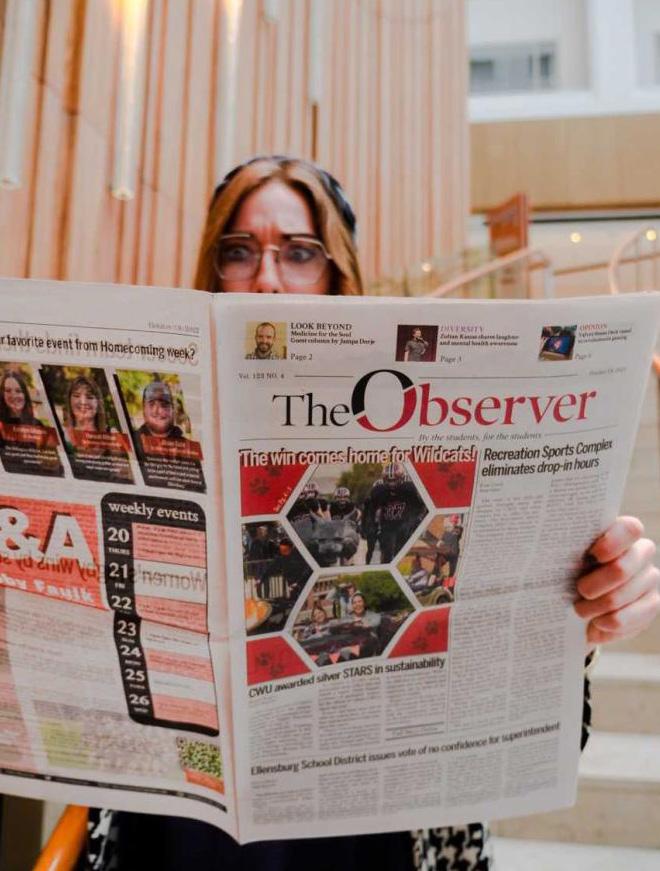
With love and season’s tidings,
Gender-Based Violence Prevention workgroup to review policies, practices and programs
Megan Rogers Senior Reporter
CWU announced on Nov. 10 its plans for a new gender-based violence prevention workgroup. The workgroup will be meeting on a regular basis shortly after Nov. 30.
The workgroup will be made up of a total of 12 representatives; four student representatives from the ASCWU, four faculty representatives from the Faculty Senate,who is the governance at CWU, two exempt representa tives from the Exempt Employee Council, who provides support of exempt employees, and two classified representatives from the Classified Employee Council who is the information conduit for CWU.
“The group will be responsible for carefully studying current pol icies and practices and programs that govern our campus approach to gender-based violence preven tion and to identify where we’re
demonstrating effectiveness,” An drew Morse, chief of staff and inter im vice president for public affairs said. “As well as to develop a set of actionable improvements that we can make related to gender-based violence prevention and handling.”
Morse said one of the out comes of this group will be to
The Violence Against Women Act has been reinstated by con gress on Mar. 15. Due to the act’s reinstatement, Morse said that he is expecting that the Biden Administration will release rules for universities on how to re spond to gender-based violence in Title IX and the Clery Act.
“We recognize this is actually a really good time for the uni versity to be taking a fresh look with these policies changing and evolving as well as what our cur rent practices are,” Morse said.
we fully engage the needs, con cerns and opportunities that our campus community has shared with us.”
Mark Samples, faculty senate chair and associate professor in music, said he is appreciative that this workgroup can improve the safety of students and employees.
“This [is] an opportunity to learn about best practices re garding equity minded in trauma informed care at the university,” Samples said.
create a set of recommendations for the university and the shared governance leaders that can help to deliver both trauma-informed care and equity-minded care.
“Another important related outcome is that we must contin ue to assure that our policies and practices comply with the con stantly evolving legal regulatory landscape, affecting Title Nine and non-discrimination practic es on campus,” Morse said.
Morse said he also thinks tak ing steps towards CWU’s vision of being a model learning com munity that creates equality and belonging is an important out come of this workgroup.
“What that means is that as we pursue this vision, working together to become a safer and more equitable living, learning and working community is crit ical to our success,” Morse said.
“We want to make sure that we are open, transparent and that
Samples said having work groups like the gender-based vi olence prevention one is import ant because it brings representa tion from all across campus.
“We want to be a learning in stitution. We want to get bet ter. It’s what we do as educators and as an educational institu tion,” Samples said. “If we real ly want them to become a com munity of equity and belonging … having these conversations is a critical way for us to move closer to that goal.”
November 22, 2022 Page 02
The Observer
Editorial Policy: The Observer is a public forum for stu dent expression, in which student editors make policy and content decisions. The mission of The Observer is two-fold: to serve Central Washington University as a newspaper and to provide training for students who are seeking a career in journalism. The Observer seeks to provide complete, accu rate, dependable information to the campus and community; to provide a public forum for the free debate of issues, ideas and problems facing the community at large; and to be the best source of information, education and entertainment news. As a training program, The Observer is the practical application of the theories and principles of journalism. It teaches students to analyze and communicate information that is vital to the decision making of the community at large. It provides a forum for students to learn the ethics, values and skills needed to succeed in their chosen career. If you have questions or concerns, email us at cwuobserver@ gmail.com. Lead Editor Katherine Camarata News Editor Evan Couch Scene Editor Morgana Carroll Sports Editors Jacqueline Hixssen Isaac Hinson Opinion Editor Katlyn White Online Editor Madison VanRavenhorst Copy Desk Lead Katlyn White Graphic Designers Glacie Kehoe-Padilla Photographer Brevin Ross Senior Reporter Megan Rogers Staff Reporters Omar Benitez Jahleel Breland Kat Cardenas Brittany Cinderella Zaire Eltayeb Devin Guerra-Burnett Kimberly Lariviere Beau Sansom Andrew Ulstad Faculty Adviser Jennifer Green Editorial Consultant Francesco Somaini A LOOK BEYOND @CWUObserver CWU Observer @CWUObserver cwuobserver@gmail.com cwuobserver.com
was awarded a new grant by the
to assist
CWU
Washington Student Achievement Council
with housing insecurity and houseless students, according to CWU News.
Plaid Friday will be Nov. 25, meaning that shoppers for Black Friday are encouraged to shop small, according to The Daily Record. A scammer posing as a country singer narrowly convinced two people to rob an Ellensburg home, according to KPQ.
Katherine Camarata Lead Editor
Photo by Dylan Hanson
“We
wanttogetbetter.”
- Faculty Senate Chair Mark Samples
STIGMA
Sleeping disorders and abnormalities
Katherine Camarata Lead Editor
Sleep is necessary to maintain physical and mental wellness yet many humans experience sleep impairment, with 28% of the U.S. population reporting excessive sleepy feelings throughout the day according to “Abnormal Psycholo gy” by Barlow et al.
These conditions include a range of disorders from insomnia to hy persomnia, narcolepsy to sleep apnea and sleep paralysis. The Observer interviewed two CWU community members to feature their experiences with sleep paral ysis hallucinations and idiopathic hypersomnia in the hopes of sup porting those who also experience these symptoms and spreading awareness.
Sleep Paralysis & Hallucinations
According to the National Insti tute of Mental Health, sleep paral ysis is “the state associated with the inability to move” when an indi vidual is waking up or dozing off as they transition to or from Rapid Eye Movement (REM) sleep.
This state can cause vivid and dis turbing hallucinations while the in dividual is paralyzed, some of which are “hypnopompic,” occurring as a person is waking up, or “hypno gogic,” occurring when an individ ual is falling asleep. These halluci nations may be responsible for a portion of claimed UFO sightings, according to a study by Spanos et al. in 1993, which showed that 60% of reported UFO sightings were asso
ciated with sleep episodes.
According to statistics shared on the NIMH website, 8% of the pop ulation has experienced sleep pa ralysis. This phenomenon is often accompanied by a feeling of pres sure like something is sitting on the chest, as was the case for CWU alumna Meghan Rochelle.
Rochelle said she had a traumatic experience having to put her dog to sleep during her freshman year, and later that night had her first experi ence with sleep paralysis.
“When I was falling asleep, I heard my dog’s collar ringing, which is very traumatizing because I thought my dog was alive for a second,” Ro chelle said. “I was asleep. I could hear my dog’s collar ringing, I could see myself in my room … I didn’t know if I was hallucinating or not.”
Rochelle said it felt like some body was sitting on the edge of her bed, perhaps her mother, but in the morning she asked her mom and her mom said she had not come into Rochelle’s room.
“I felt a very negative energy in the room,” Rochelle said. “I’m not normally like a very spiritual person, but I felt it was very de monic. Then all of a sudden, I felt the pressure on my chest … I felt like someone was pushing on me, and forcing me down. All I could think was ‘don’t wake up, don’t wake up.’ Because if you wake up and someone is in your room, that’s more scary than if you just keep your eyes closed.”
Rochelle said she has experi enced sleep paralysis 10-15 times since this occurrence in 2016 and that these experiences have
caused her to have spikes in anxi ety and paranoia.
Rochelle said the “most terrifying” experience she had involved seeing a man she had never seen before in her room who appeared to be real.
“Last year, I was sleeping at my par ents’ house for the holidays,” Rochelle said. “I woke up and I saw an actual person in my room. They were very solid looking. He had a face mask on, like a COVID-like face mask. He had Timberlands on, a plaid jacket, curly hair, wearing a beanie and he was staring at me … I woke up and I was screaming at him.”
Rochelle said she yelled at him asking who he was, and tripped out of bed toward the figure. When she reached for him, she said he disinte grated like a ghost or a hallucination.
“I thought, ‘I’m not dreaming, I’m clearly awake,’ and I started going crazy,” Rochelle said. “I’m having hallucinations when I’m actually awake. That’s when I discovered what hypnopompic and hypnago gic hallucinations were, and that you can lose patience when you wake up and it feels so real.”
Rochelle said she has faced stigma when discussing sleep paralysis with medical professionals, who often categorize these hallucinations as just nightmares. Rochelle said first having these hallucinations made her and her family question her mental stability.
“I have never been diagnosed with anything regarding mental health issues besides ADHD, and depression and anxiety,” Rochelle said. “So having these hallucina tions made me wonder. I got to the doctor to see about what’s going on and as soon as I told them, I felt like
due to the lack of visible symptoms.
“With IH, your brain doesn’t tell your body to be awake, it just tells your body to be sleepy, no matter how much rest you get,” Colwell said. “The idiopathic part of the name means doctors and researchers don’t know why your brain does that.”
Colwell said she takes prescribed stimulant medications like Adderall and is also prescribed Iron supple ments to help her stay awake.
Colwell said she took a sleep study test two years ago when she was 16.
I could feel the judgment … Because doctors, they can’t really diagnose you with that easily. You have to go to see a psychiatrist, and I tried to make an appointment, but [in her location] they didn’t have any avail ability until six months later.”
Rochelle said people with this condition can be more supported by CWU and the counseling center if there was a space of non-judg ment where these types of behav iors could be discussed openly.
“I feel like professors can take mental health issues more seriously, mental health days are important,” Rochelle said. “I had a lot of people [at CWU] judging me, the medical center there, whether it be the doc tors and nurses that they hire there … I feel like they can always be a lit tle bit more compassionate towards people with mental health issues.”
Rochelle said she knew people who didn’t reach out to Student Counseling Services because they were worried about feeling judged
“My aunt has the same condi tion, so she was able to support me with fighting my own doctors to push them to do more testing,” Colwell said.
Colwell said eventually receiving a diagnosis helped her receive the medications she takes currently and the accommodations she gets from Disability Student Services (DSS) on campus.
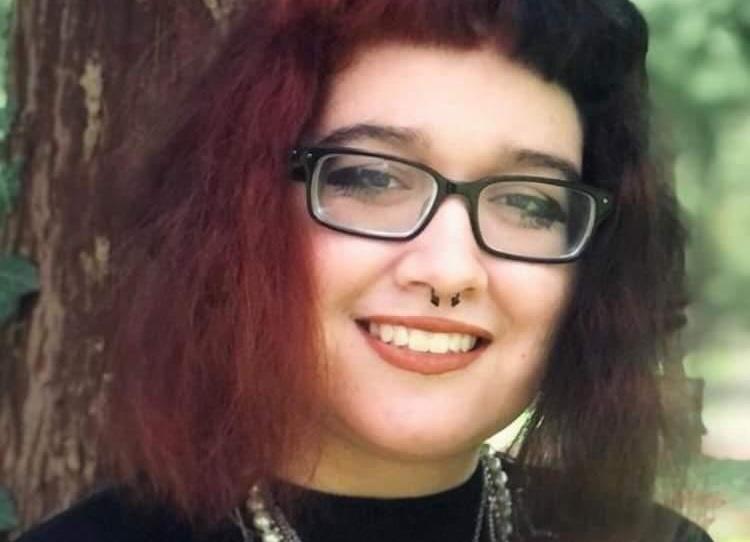
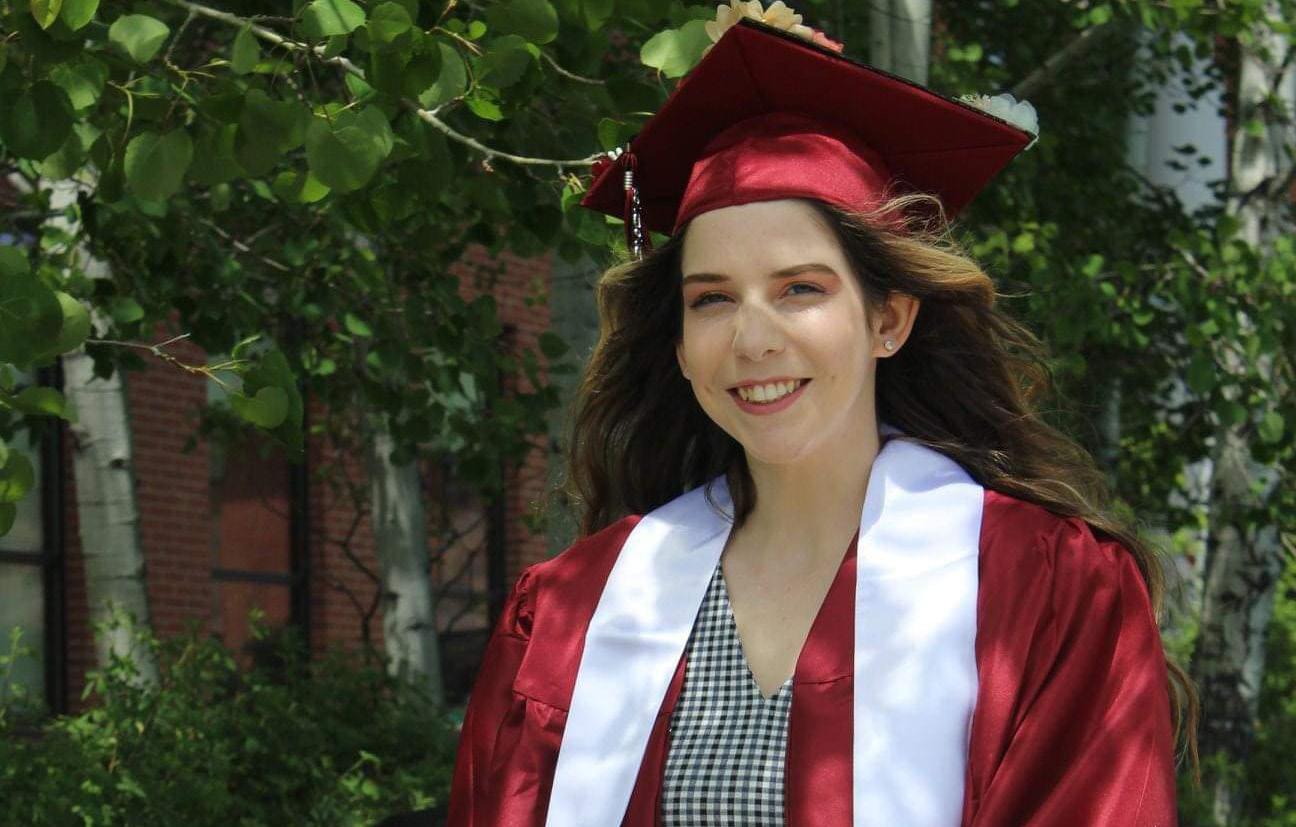
in treatment, a common concern expressed by those who do not seek mental healthcare.
Rochelle said those who know people with sleep paralysis can be understanding to them by asking questions like: can you tell me why it’s happening, what you’re seeing, how does this make you feel? Is there anything I can do to help you in reducing your stress? Is there anything I can do to help you feel better?
“In my experience, they’re not life threatening,” Rochelle said. “But it feels life threatening in the moment. If people could under stand that there’s a real fear behind this and they’re not just dreams, they’re real life experiences that you’re experiencing fully conscious in the mind. I wish people would understand that if you believe that it’s really happening to you, that’s enough to be traumatizing. This is a real issue that people deal with on a daily basis.”
portive of individuals with sleeping disorders by not being upset if they need to cancel last minute, because “it’s not their fault they’re tired. You have your bad days and your good days, the people in your life should know not every day is going to be the same for you.”
Idiopathic Hypersomnia
According to the National Li brary of Medicine, idiopathic hypersomnia (IH) is “a chronic neurological disorder that results in daytime sleepiness, frequently accompanied by long nocturnal or daytime sleep, unrefreshing sleep, difficulty in awakening, cognitive dysfunction, and autonomic symp
toms.” It is similar to the sleep disor der narcolepsy, and is often treated with the same types of stimulant medications.
Ella Colwell, a freshman studying social studies education, said her ex perience with idiopathic hypersom nia can manifest in sleeping for up to 16 hours a day. Colwell refers to IH as an “invisible illness” that is often not believed when people speak about it
“They hook up a bunch of wires to you to read your brain waves and your heart rate, and they can tell when you go into REM sleep,” Colwell said. “With idiopathic hy persomnia, you have to fall into REM sleep within three minutes of closing your eyes.”
Colwell said she went through high school sleeping every hour in between school time. She said she experienced a lot of “medical gaslighting” because her blood work came back normal and she felt doctors only thought she had depression and anxiety, not a sleeping disorder.
Colwell said a diagnosis isn’t needed to treat symptoms, which can be helped by taking Vitamin D, going outside and drinking water, but she said the diagnosis can be helpful for those seeking treatment.
Colwell said DSS didn’t initially recognize idiopathic hypersomnia as a condition when she first ap proached them, and she had to pro vide a lot of evidence to prove her condition. She said she hopes DSS can be more open minded to invis ible illnesses they haven’t heard of.
“Now it’s recognized through DSS, so other students who have it will hopefully not have to go through a month without accom modations like I did,” Colwell said.
Colwell said people can be sup
Colwell said she also really likes when her friends ask her about her condition instead of making assumptions.
“Everyone who has IH experi ences it differently too, so you can’t just rely on one internet source to know everything about your friend’s condition,” Colwell said.
Colwell said she avoids her bed at all costs during the day and stays busy to combat the symp toms of her disorder.
Colwell encouraged students who may have sleeping disorders to not give up hope.
“Don’t let it stop you from doing the things you want to do,” Col well said. “There’s always some kind of accommodation or some way you can compromise. Don’t think of having a sleeping disorder as a death sentence for your life.”
November 22, 2022 Page 03 @CWUObserver CWU Observer @CWUObserver cwuobserver@gmail.com cwuobserver.com
THE
BREAKING
CWUalumnaMeghanRochellesharesherstory.
Photo courtesy of Meghan Rochelle
EllaColwell,freshman,opensupaboutherexperience.
Photo courtesy of Ella Colwell
Presence of theatrics
Hotter, newer and jammier: Hot New Jam’s found families
Andrew Ulstad Staff Reporter
The sounds of laughter punctuated by one word sug gestions rang through Hebel er Hall on Friday, Nov. 18 as improv troupe Hot New Jam hosted their weekly meeting and team play session. With seven new members in the troupe, these sessions serve as exercises for their creativity.

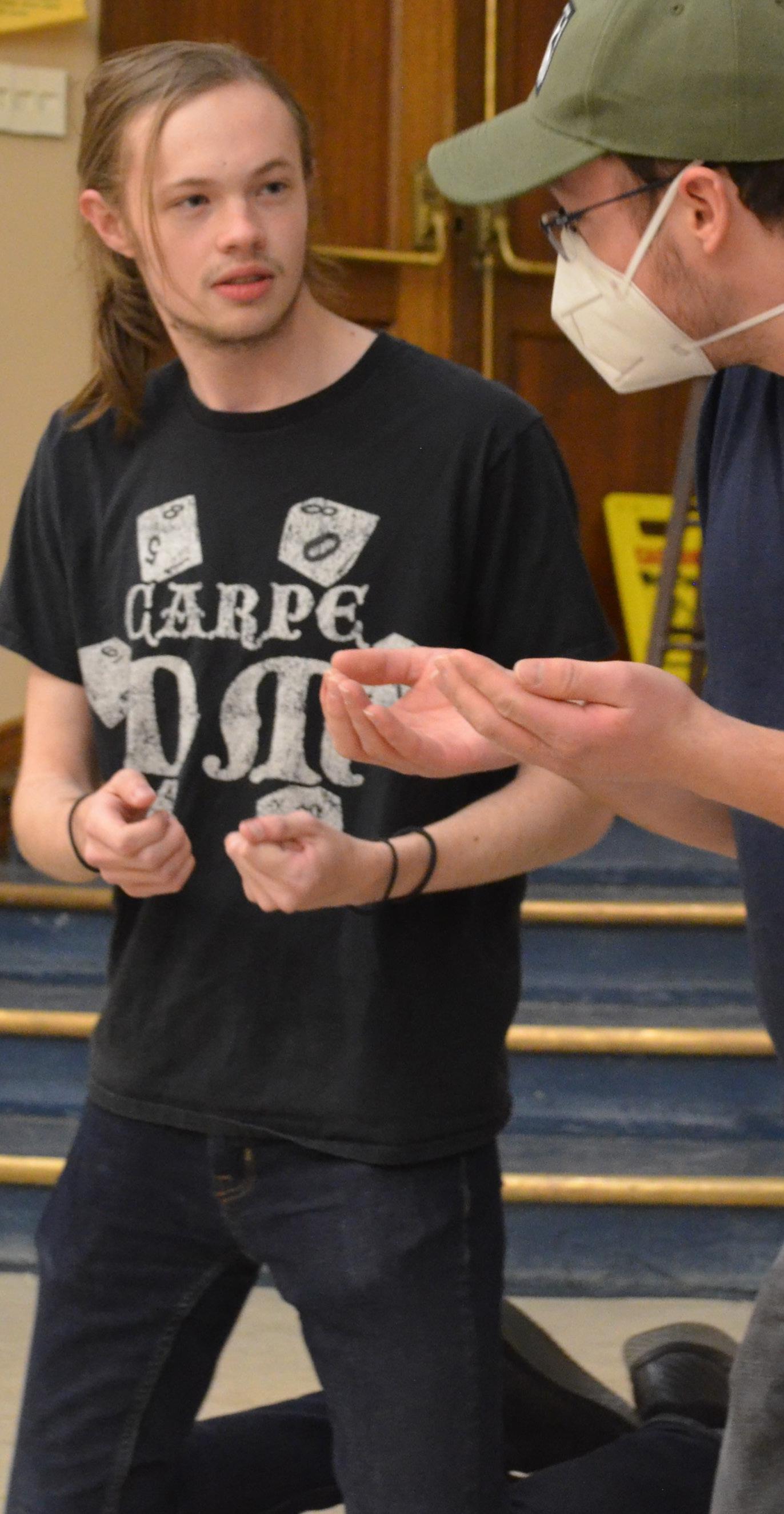
Improvisation can mean many things depending on who is asked. For senior Presi dent Marcus Wolf and the Hot New Jam troupe, it means cre ating a community.
“We all back each other up, no matter what,” Wolf said. “On their second week of be ing on the team, [the troupe] did a show in front of 100 peo ple and there was such great trust and camaraderie … that’s the thing I’m going to miss the most about Hot New Jam is this team.”
His sentiment was echoed by senior treasurer Brad Alemao. “We have a lot of different

personalities mixing in the most interesting ways,” Ale mao said. “Improv is its own little family. We all just goof around, have a good time and then we get on stage and do the same thing.”
In addition to the sense of family being created among members, small communi ties have formed around the troupe.
“[Hot New Jam] allows for students on campus to be like, ‘you know what, this is some thing I’m going to do with my friends,’ it’s a way of helping others to build their own com munity,” Wolf said.
Still more students find be longing in the group’s free play nights, which allow any one to partake in the improv games that end up building the monthly shows.
Secondary mathematics teaching student Austin Smith said he comes to free play night to scratch his perfor mance itch. He has also found the group to be open and wel coming.
“From the moment I walked in … I just felt immediately like, ‘you know what, this is a great place,’” Smith said. “I feel I can just be myself here, I don’t need to think of anything other than just how to have fun.”
Regardless of the reason for showing up, many mem bers, free players and audi ence members have gained a sense of belonging from their time creating laughs with the troupe.
Hot New Jam will host their final performance of the quar ter on Friday, Dec. 2 at 9 p.m. in the SURC theater. This will be Alemao’s last performance before graduation.
In his final hours before his ‘stage death,’ as the troupe calls it, Alemao encourages students to: “find that sense of community in themselves and each other, because [while] Hot New Jam is a family, we’re not the only family that can be formed … it’s possible to just find a common interest with a group of people and really cre ate a found family.”
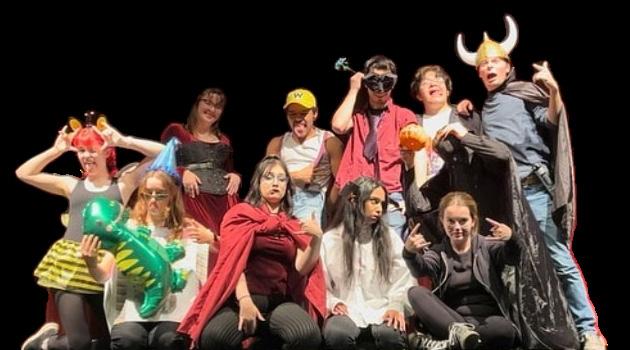
Page 04
HotNewJamteammemberSayliKenibecamealostfishinthisscenewith TomHinkle. Photo by Andrew Ulstad
SophomoreAustinSmithconveysconfusionwhileplayingaboyscoutduring HotNewJam’sfreeplaysessiononNov12. Photo by Andrew Ulstad
MembersofimprovtroupeHotNewJamcelebrateHalloweentogetheronstage. Courtesy of HotNewJam on Instagram
theatrics felt on campus
explores life, death and everything in between Cast on continuous rotation for lottery role selection
Katherine Camarata Lead Editor
All four quadrants of theatre seats held anticipatory audience members facing each other with in the intimate setting of the Milo Smith Tower Theatre on the opening night of the production “Everybody” by the CWU Theatre Department. Purple light bathed the set made of stone structures eye-catchingly reflecting the light as a lively usher instructed viewers to turn off their phones.
“Everybody” by Branden Ja cobs-Jenkins is a modern adapta tion of the 15th century morality play “Everyman.” The intensity of the dialogues and monologues captivated the audience. On oc casion, the entire theatre plunged into darkness as Everybody twisted and turned throughout life, death, dream and reality, wondering how to distinguish between these states. Five roles were randomly selected from a lottery wheel on stage to add a touch of intrigue and challenge.
The play opened with the usher transforming into an illuminated God complete with deepened and robotic vocal effects played by Peter James. His booming voice expanded across the audience as it pondered the meaning of life, tormented over the audience’s laughter and said: “I need no eyes, I possess the vantage of Divinity … perhaps I am speak ing to noone, only myself.”
According to the director’s note, the play explores themes of what a life well-lived looks like and what the word “good” means to begin with. These life or death themes were presented through a lens of comedy and modern social dilem mas like gender and racism.
Rollie said the playwright Ja cob-Jenkins is a member of the Black and queer communities and flips historical scenarios around while asking the audience tough questions.

Rollie said the switching of actors between roles is a way of “destabi lizing” ideas around identity.
“Rehearsals have been fun and kind of avant garde in some ways because we’ve had to track who has played which role in rehearsal,” Rollie said. “It’s improvisational but also the actors who draw the roles know the whole script.”
House manager and assistant
Jinx Willow, an audience mem ber and senior in theatre studies, had attended the show twice by Friday. Rollie recommended view ing the show more than once to witness the varied nuances.
“Depending who is playing Ev erybody, the feeling you get is dif ferent,” Willow said.
A stand-out moment included the character “Stuff” played by Julia
because everybody changes every night, I had to learn everybody’s mannerisms and their reactions.”
During the opening show, Cessna was planted in the audience to start. She said of the experience: “Having an audience is really helpful because we get to feel that energy. Also, I’ve never had to climb over somebody to get into a small space, so it was more interactive than it has been previously.”
First year in Theatre Studies and audience member Valerie Barra recommended that other students see the show.
“I really like the personifications of these abstract ideas like love, strength, time and how they were each made a character,” Barra said.
director Marcus Wolf said, “Each actor brings their own unique tal ent and skill and perspective to each character. Each show is basi cally watching an entirely different show.”
The director’s note ended thusly, “Before death we are equal, and per haps understanding that might also help us be more understanding of others in life.”


The voice of Death who “fears no man” played by Shawn Mulligan thundered around the theatre as the character’s anger grabbed a hold of the audience during an evocative scene before Everybody’s journey.
Throughout Friday’s show, lead character “Everybody” played by Malik Cantú was on a journey to face death, accompanied by every good and bad deed they ever com mitted while trying to bring others along with them.
Friday was a special occasion in many ways for Cantú.
“It was a pretty big deal for me today because today’s actually my birthday too,” Cantú said. ”To be able to play that role, it was just a lot of fun. It was definitely challenging, but I was really excited to jump into it.”
Seligman wearing a giant cape cov ered in miscellaneous bright objects and gloves. Stuff said she couldn’t accompany Everybody into death, and the play harkened to ideas of emotional attachment to material items and how this distracts man kind. Their chemistry showed a soft understanding.
Everybody tried to convince characters like Cousin played by Seamus C. Smith, Kinship played by Mason Sallee and Friendship played by Yuka Kawai to join them on this quest, however Everybody ended up facing a lot in life alone.
A chilling and thrilling dance scene involved the cast circling around the set executing chore ography while wearing skeletal costumes.
At the end of Everybody’s existence, only one character remained alongside them as they ventured off upon their final voy age toward death.
Some roles were played by the same actors each night, as was the case with Cessna’s character Love.
“My role, it was a little bit easier than some other roles, because I just had to know lines for myself for my character,” Cessna said. “Also,
“The main thing that I took away was that love sort of prevails and that’s one of the things that matters most in life.”
Rollie said she hopes students walk away from the show with an inquisitive spirit.
“This play has such big ques tions for us all to consider,” Rollie said. “Like, how do we change this world? And how do we live in this world?”
Page 05
“Everybody”
Dec. 1-3 @ 7:30
Dec. 4 @ 2
“Everybody” showtimes
p.m.
p.m.
MalikCantú,JosephineCessnaduringrehearsal. Photo by Sequoia Good
ShawnMulliganhavingamomentatrehearsal. Photo by Sequoia Good
“It’simprovisationalbutalsotheactors whodrawtherolesknowthewholescript.”
- Director Emily Rollie & Associate Profes sor of Theatre Arts
Sharing perspectives
The art of protest in Iran
The expression of revolution and the display of the oppressed
Morgana Carroll Scene Editor
Protest isn’t always done through the usual means of marches and cheers, according to Professor of History of Art and Architecture at the University of Massachusetts Dr. Pamela Karmi. Art has been used as a form of protest in Iran since be fore the 1980s.
According to Karmi it used to be more underground and subtle, often taking place in remote areas where the morality police aren’t likely to intrude, but now with re cent events that have happened in Iran Karmi describes recent protest pieces as “in your face.”
The Museum of Culture and Environment hosted a webinar on Nov. 19 where they invited experts in the Iranian region and history to speak about the country’s civil unrest, both the protests that have sparked up since Mahsa Jina Ami ni and the displays of struggle that were happening before the Moral ity Police’s arrest.
“[Protest] art is so important be cause in the last 43 years Iranians have not had the opportunity to form opponent political parties to the central government,” Karmi said. “Since we haven’t had these

opponent political groups, people have had to express their griev ances, their opinions that are often against the central regime, in differ ent forms, in the form of literature, in the form of art and in the form of theatrical performances.”
Karmi said that one of the reasons that protest art has been so preva lent in Iran recently is because of the power of social media.
“It’s particularly powerful because of social media,” Karmi said. “Peo ple don’t have time read hundreds of texts written by journalists on social media. But they do have time to glance over an image, and a pow erful image is worth 1000 words.”
An example of Iranian protest art going viral was the song Baraye by Shervin Hajipour. According to Karmi Baraye became the unofficial protest song of Iran and Hajipour was arrested just days after posting.
“Sheravin posted Baraye, which means for the sake of or because, recorded in his room and posted on Instagram for his followers and was shared more than 40 million times on social media platforms in just two days,” Karmi said.
According to Karmi another pro test display that spread rapidly over social media was the red fountain in Tehran. An anonymous artist dyed
the water in a historic fountain red.
“An anonymous artist made Teh ran in Blood, dying fountains in im portant cultural centers red,” Karmi said.
Karmi said that the one piece of artwork that had to make her look twice in case she wasn’t seeing things right was the tampon flow ers on security cameras.
“A bunch of anonymous wom en went into the Tehran metro stations and they covered the sur veillance cameras with tampons,” Karmi said. “And the way that they have placed these tampons over the security cameras, it makes them look like little flowers in the ceil ing.”
Karmi said that she couldn’t tell that it was connected to Iranian protest art at first when she saw it on social media. She said that this is an example of how protest art can sometimes be mistaken for general art pieces.
“The first time I saw the picture I said ‘Okay who’s doing these flowers on the ceiling? It’s kind of boring, I’m sorry,’” Karmi said. “But then I noticed that they were tampons and they are actually real works of resistance against sur veillance and against the morality police.”
CWU’s education abroad fair connected students with travel opportunities
Megan Rogers Senior Reporter
CWU hosted the Education Abroad Fair in the SURC on Nov. 16. The purpose of this fair was to introduce students to the different options avail able through CWU and partner ing organizations for studying abroad.
The Education Abroad Fair had representatives from the Study Abroad and Exchange Program’s office, faculty-led programs and CWU’s partner organizations.
Matthew Zielsdorf, senior study abroad advisor, said the message they hope to get across at the fair is that studying abroad can be accessible, affordable and life-changing.
“Those experiences translate to other things, like, having the intercultural experience and be ing able to understand that other people come from different plac es or to get that global perspec tive too that directly translates into your career,” Zielsdorf said.
Colton Oliphant represented WorldStrides, one of CWU’s partner organizations. Oliphant said what makes WorldStrides unique is that they offer different support services, such as a resi dent director who are dedicated to making sure students have a well-cared-for experience.
“If you were not quite sure how a cultural interaction [went], maybe someone was frustrated and you didn’t understand why, the resident director will give you information on what may have happened and talk through it,” Oliphant said.
Oplilant said that WorldStrides will also have an apartment set up for students in the place they are studying abroad and resident directors can help students work with the contractors if any main tenance problems arise.
WorldStrides gives students options to travel to the United States, Africa, Asia, Europe, Cen tral America, Oceania and South America.
Richard Menard was repre senting the University Studies Abroad Consortium (USAC) at the fair. Menard said USAC tries to keep studying abroad afford able for students.

“We [USAC] go to a secondary city. We’ll be in Pau or Lyon in France and in Italy, we’re in Ve rona and Reggio Emilia,” Menard said. “[It] helps keep down the costs and because we’re like one of the only organizations that’s
there, we’re not fighting with everybody else to find housing or compete with faculty or staff.”
Students also have the option to do internships abroad. Chris topher Adams was representing IE3 Global which is a company that offers international intern ships to students.
“We do operate on a quarter schedule like CWU so we can be a good fit if you don’t want to do a whole semester abroad, like a lot of other programs,” Adams said. “So you’re working 35 to 40 hours a week on-site with a small to medium-sized business that’s going to be mentoring you in your field of interest for an in ternship.”
Keith Lewis, professor of jew elry & metalsmithing at CWU, was at the fair talking about the study abroad programs the Art and Design Department offers.

“We [the Art and Design De partment] offer some short-term study abroad programs that start with a course here on campus to learn a little bit about the history and art of the place we’re visit ing,” Lewis said. “Then we usu ally spend 12 or 14 days at a site.”
Lewis said you don’t have to be an art major to be a part of this study abroad program.
Steven Cook, associate direc tor of education abroad, said students who are interested in the study abroad programs can join the virtual information sessions that Study Abroad & Exchange Program hosts. The sessions take place every Tues day and Wednesday from 11 a.m. to noon.
“If they can’t make it… they can reach out to either myself or to Matthew Zielsdorf and schedule a one-on-one appointment to kind of talk about different op tions,” Cook said.
Cook said having study abroad options for students is important because it allows them to gain in tercultural skills.
“Having an experience that is crossing cultural lines can help inform how you work with [dif ferent] populations,” Cook said.
Cook said studying abroad can also allow you to gain ac cess to different kinds of aca demic programs that may not exist at CWU.
“Ellensburg isn’t exactly a trop ical location. So if you’re inter ested in Tropical Ecology or bi ology, then going to a place like Costa Rica, where those things are, are in their natural habitats,” Cook said.
DIVERSITY THE
@CWUObserver CWU Observer @CWUObserver cwuobserver@gmail.com cwuobserver.com
Page 06
Translation:“Thismassivearmyisuseless.Indeed,asinglefightinggirlisworthhundredsofthousandsof them.” Courtesty of Pamela Karmi
Art for the blind A R T F O R T H E B L I N D
born in London to Jamaican immi grants. He now lives in Portland, Oregon. After blindness brought an end to his textile design business, he turned to three-dimensional assem blage art and wood carving.

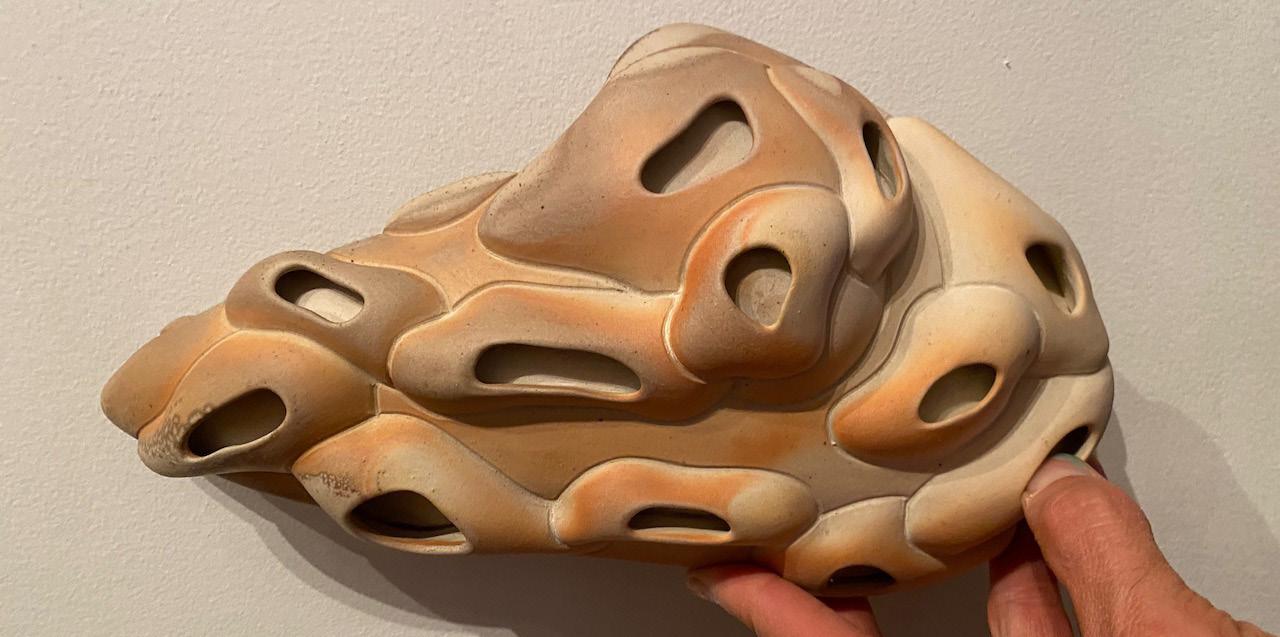
What is beauty? It’s of ten been said, “Beauty is in the eye of the beholder,” and this might be so, but if you are blind, beauty is felt by the handler.
In his October 2019 Poetry Mag azine essay, “Tactile Art,” deafblind poet John Lee Clark writes about art he can touch: “What shall we call it— tactile grammar, semiotics of touch, Protactile aesthetics, tactiletics? True tactile art must have language. It should express and extract mean ing. Texture, contour, temperature, density, give, recoil, adsorption, and many other elements are units in this language.”

The message in Clark’s essay has guided Professor Gregg Schlanger on his mission to find art for a new residential hall at the Washington State School for the Blind in Van couver, Washington. Schlanger, an installation artist and Chairman of the Department of Art and Design, is known for his community-ori ented art projects. I asked him what inspired him about this project and he said, “I love a challenge.” The State Arts Commission paired Schlanger with Chris Downey, who is the ar chitect for the project.
The term aesthetics is a modern term. The ancients conceived of aesthetics as “sensation” or as a re sponse to stimulation upon the dif ferent sense faculties, hearing, see ing, touching, smelling, and tasting.
In his treatise, exander Gottlieb Baumgarten (17061757), a German philosopher, gave the word a new usage: “taste” in the sense of a person’s ability to judge what is considered beautiful or wor thy of value. This is how we use the term today, or at least until recently.
A new form of aesthetics is emerging called Disability Aes thetics, which reveals to us that an understanding of disability is crucial to the way we under stand modern art (Disabil ity Aesthetics, Tobin Sie bers, University Michigan Press, 2010).
Downey, the architect of the project, is blind. He was not born blind. He was a practicing architect before a tumor affected his optic nerve and caused his blindness. Undeterred, he turned this challenging experience into an op portunity. He retrained himself in the basic skills necessary to live as a blind person and was then able to create braille-like architectural drawings and an innovative way to make alterations to standard draw ings. (Chris Downey | Architectural Digest)
One of the first artworks Schlanger purchased for the residence hall is by Dell Fine Artist, a blind sculptor
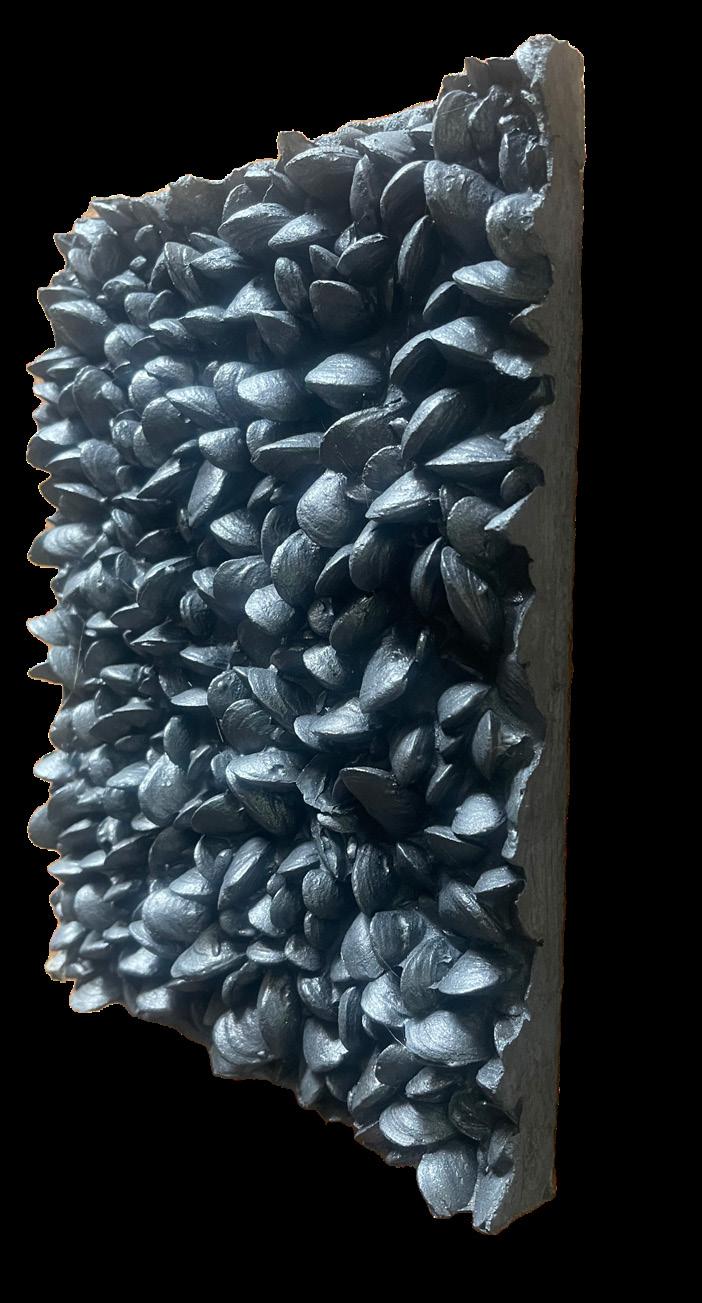
“Piece of the Pie” (2019) incor porates Braille and is made for a hands-on experience. According to his website: “Del seeks to reclaim or establish a portrayal of Black folk in the history of Western culture. In herently political, his work aspires to be accessible to an inquisitive audi ence that enters with an open heart and mind.”
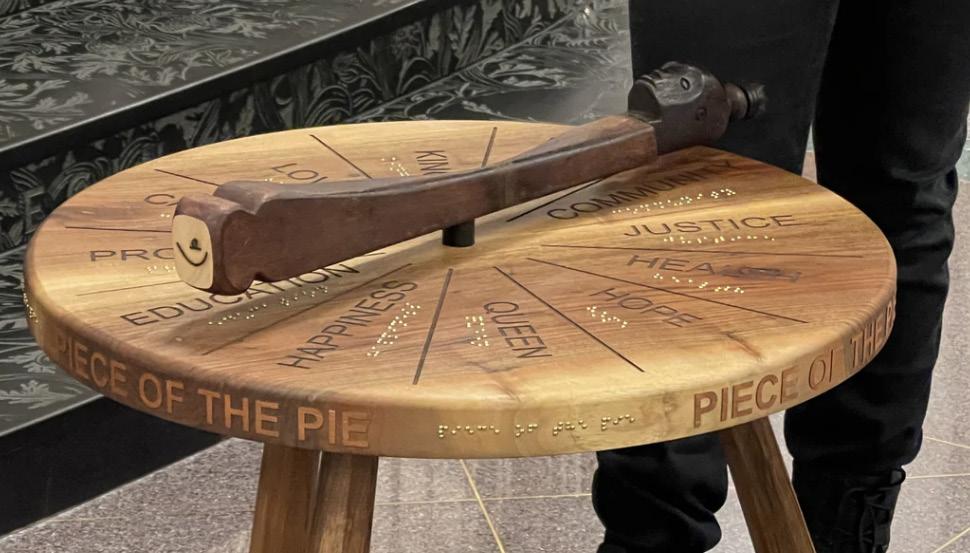
Another blind artist whose works will be present in the resi dence hall is Michael Naranjo, who said: “Being blind makes the pace of life slower; you can’t walk fast or grab for things quickly. Life is more gentle and soft and the
two members of the CWU Art and Design faculty: Howard Bar low, who teaches sculpture, and Stephen Robison, who teaches ce ramics. He also picked Crista Ann Ames, who is a resident artist and Studio Manager at Gallery One in Ellensburg. The biographical note that Schlanger sent me read: “Cris ta Ann Ames is a sculptor working primarily in ceramics and textiles. Through the layering of mythology, iconography and personal narrative, Crista explores how our own an imal nature relates to the ways we establish and sustain personal rela tionships. Raised on a small hobby farm in Washington State, Crista often draws on her own experiences to explore pastoral life, animal hus bandry, women’s craft, and fertility.” “Lamb’s Head” shown here.
Barlow told me that “Shuck #1” was already cast before the call came, and that he felt this bronze would be just right for the residence hall be cause of the sensuousness of the shell shapes.
will be predictable and generous.” In this sense, designing for the blind works both ways in making the world a more comfortable place for everyone to live. It is an attractive proposition to reach out to those who are limited in their appreciation of the visual world that surrounds us, and they can reach out to us with their Insight.
According to John Lee Clark, “the goal of the Protactile movement is for us to get, do and make everything in our own way. After we peeled our language away from visual sign language and remade it completely, reciprocally and proprioceptively tactile, Protactile storytelling, Prot actile poetry, and Protactile theater quickly emerged. It makes sense that those forms would come first, as they do not require that we buy anything or lug equipment around or hammer something together. Just ourselves and each other. Protactile theater, though, is starting to play with costumes and props. Does this mean Protactile art is next?”

Naranjo: “In 1968, after just a few months in Vietnam, Michael Naranjo was blinded by a grenade. While recu perating in the hospital in Japan, the wounded 23-year-old asked a vol unteer for some modeling clay. He’d lost the use of his right hand; with his left, he sculpted a small figure and be gan his career as a sculptor. Naranjo’s sculptures often feature the narra tives of his childhood: native dances, eagles and buffalo, women carrying water. But his work is wide-ranging — he sculpts mythical creatures, such as mermaids and centaurs, as well as cherubs and nudes. The forms he creates are simple and bold, but the surfaces have a varied texture that viewers are encouraged to touch.” The piece shown here is entitled “Rudolph.”
Among the nine artists cho sen to present art for the residence hall, Schlanger picked works by
Robison says his works have “vi ruses and diatom influences.” I asked him if he has an aesthetic theory, and he told me he thinks of line and color and occasionally a word comes into his mind but that mostly he focuses on “calligraphic reference points.”
Allen Moe, who lives in Ana cortes, Washington, spent ten years working seasonally as a park ranger in Alaska’s Denali National Park. While homesteading in the North western Brooks Mountain Range, Moe was highly influenced by Es kimo culture and by his surround ings. Other artists involved in this project are Rachael Dorn, John Fur niss, and Chris Gryder.
Chris Downey in his TED talk said, “In the disability community, there is a saying, that there are only two kinds of people, those who have disabilities and those who haven’t found theirs yet.
If you design cities with the blind in mind, you’ll have a rich, walkable network of sidewalks with a dense array of options and choices all avail able at street level. If you design a city with the blind in mind, sidewalks
And so, the mission of Gregg Sch langer and the work of the artists he selected for the project at Washing ton State School for the Blind is in step with the times. A Prot
@CWUObserver CWU Observer @CWUObserver cwuobserver@gmail.com cwuobserver.com
DIVERSITY PAGE
Page 07 November 22, 2022
Supporting awareness
“MusselBed”byAllenMoe. Courtesy of Gregg Schlanger “Pieceof
thePie”
byDellFineArt. Courtesy of Gregg Schlanger
“Lamb’sHead”byCristaAnnAmes. CourtesyofGreggSchlanger
“Flash”byStephenRobison. Courtesy of Gregg Schlanger
“Rudolph” by Michael Naranjo. Courtesy
of Gregg Schlanger
SENIOR FAREWELL
Lead
The last two years I have spent my time sitting on my computer editing numer ous articles every week for The Observer. This was the most rewarding experience throughout my time in CWU.
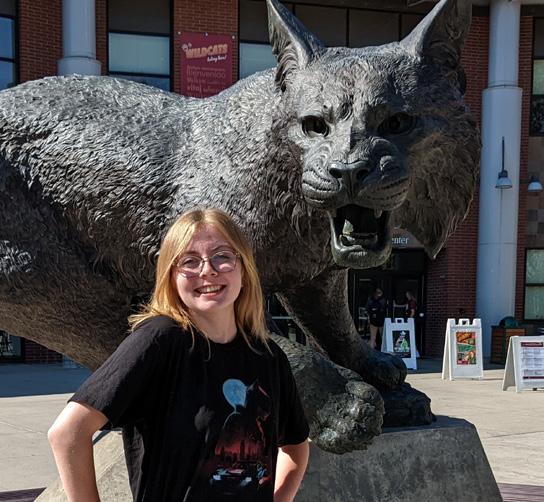
I began as copy desk staff and worked my way up to Copy Desk Lead. Being in this posi tion has been very eye opening to many things, like the in tricacies of news writing, my love for editing and the lack of public education on the rules of grammar.
I have put my blood, sweat and many, many tears into The Observer. I have felt lucky enough to participate in bring ing all these articles to their best light. I feel privileged that I was able to meet all of the past and present editors that I have worked with.
My biggest accomplishment is The Observer’s adviser, Jen nifer Green, saying that the copy during my time here was the “cleanest copy.”
I pride myself in the time spent making The Observer. Trust me, this takes a lot of effort and a lot of people to produce a weekly publication, so please share The Observer with classmates, friends and family.
My work here in The Ob server is what I believe got me into my dream program this summer. The New York Uni versity Summer Publishing Institute has been my dream since I was 12 years old. I knew I wanted to go to this summer program before I knew what college I wanted to go to. I credit my time at CWU, The Observer and other opportuni ties here for getting me a spot for the 2022 program.
Aside from The Observer, which took up 90% of my time, I took classes for Professional and Creative Writing classes and Journalism. I was the ed itor for the Her Campus chap ter here at CWU. I have read over 250 books through the past three years and a quarter.
I am proud of myself for graduating. I am proud of my accomplishments here. I am proud of the path I have cho sen in life and am excited for the next steps.
Thank you CWU, and thank you so much Observer.
Viewing outer space in Ellensburg
Brittany Cinderella Columinst
Whether you’re someone al ready in love with space and ev erything around us or just like to see the moon from your backyard, take time out of your day to ex plore the stars.
If you’ve ever had a chance on a clear night to stare up at the sky in Ellensburg, you’ve seen the beau tiful blinking stellar objects above you. After moving to Ellensburg during my freshman year from the west side, I was drawn to not having clouds or light pollution for the first time in my life.
I started to love seeing the stars, but I didn’t have a way to view them up close. So I asked my par ents for my own telescope, and we researched to find the best option for my desired viewing. We found the perfect telescope but needed a way to take photos
through the telescope without trying to balance my phone on the lens, so we added a ring that can be attached to my personal digital camera to take photos.
Needless to say, I can’t put my telescope away unless I’ve cap tured an image. I’ve seen Jupiter and its moons, the redness and stormy eye of Mars and the cra ter spots on our own moon. With our moon, I’ve seen both types of eclipses, lunar and solar, and photographed most of its phases. Recently I was able to catch one of the CWU aviation students fly ing their plane past the moon and it’s one of my favorite photos I’ve ever taken.
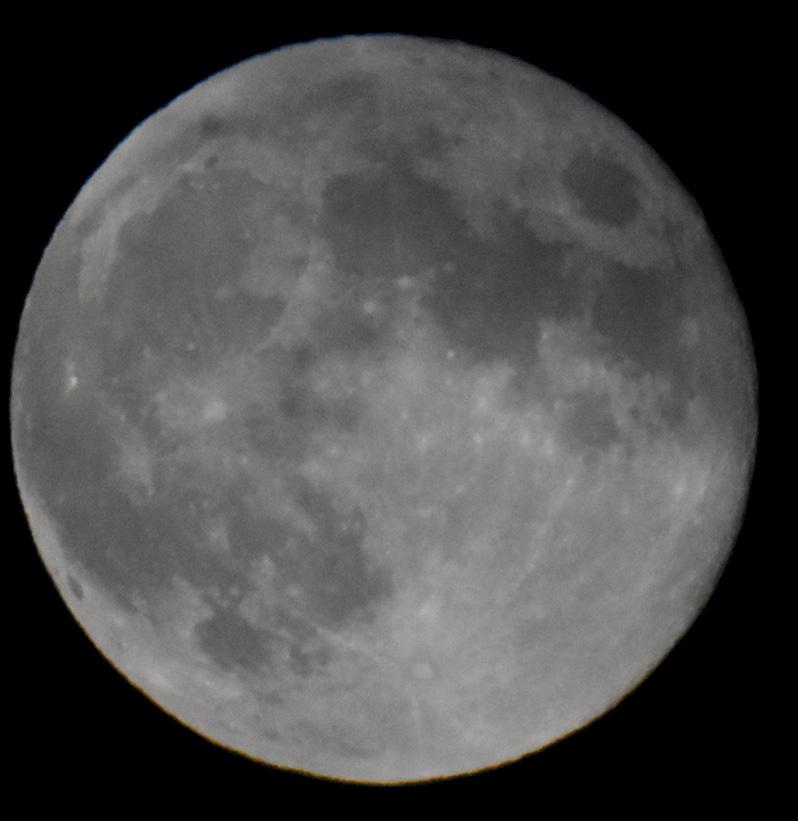
Outside of photography, I find it fascinating to see space in El lensburg from my backyard. I re member for years having to travel to a higher elevation location to see anything, but if I step out my door, I see constellations such as
Orion and both Ursa Major and Minor, the big and little dippers. With the sun setting so much ear lier in the day now since it’s win ter, it gives you even more time to stop what you’re doing and look up at the amazing sky above us.
To get slightly philosophical, the idea of space has always been something I’ve been amazed by. Since I was little I took time to look at the stars, but I never could have guessed it would be part of my col lege education.
Double majoring in Physics and English, with minors in Astrono my and Math, I’ve been able to take part in some amazing sky-viewing with my peers. In Physics 303, Ob servational Astronomy, we went up on the roof to memorize the constellations, whilst also work ing with the telescope attached to Discovery Hall. I got to take photos of a star cluster for the first time, and process the image colors to my
desire. I’ll still never be able to get over the fact that the stuff we see in the sky is only seen as it was in the past since it takes so long for the light to travel.

Of everything I’ve seen in our visible sky, I will always remember seeing Saturn for the first time. It was August of 2019, I had lined up my telescope to the bright spot that my phone app marked as Saturn, and hoped for the best. Adjusting my eyepiece into focus, I immedi ately recognized the beautiful rings and felt tears coming to my eyes.
I, a college student with medio cre telescope skills, found Saturn by myself, and saw it from my back yard. As tiny as the planet appeared, I could see it as if it were right in front of me. My camera wasn’t able to capture it well enough, so I grabbed my phone and lined it up with the eyepiece as well as I could, to capture one of the coolest photos I’ve gotten.
Public colleges should be free
The average cost for public col leges in the United States can cost up to $25,000 per year and aver age over $100,000 for a four year degree according to US News. This is a lot of money for many families struggling to afford to send their children to college.
Private colleges can cost a lot more. Currently, the average debt that a college student gradu ates with is $28,000, according to CNBC. To give more opportuni ties for everyone to get a higher degree, it would be beneficial if all public colleges were free.
If college were to be free, I could envision being able to get more than one degree, which
would allow me to be more ver satile for future jobs. It could also potentially help anyone get into a graduate program that could en hance current job opportunities. When a person is free to expand their knowledge, they become a life-long learner.
According to an article done by the Huffington Post, “The cost of making public education free in America, would be between $15 and $30 billion. While this may sound like a large sum, it could actually save money.”
Currently, the government spends much more than the av erage sum on schools with low graduation rates. According to Business Insider, on aver age, only 30% of students who
start college will graduate. The Federal government spends $175,000,000 annually on main taining vacant buildings. All that seems pretty wasteful. What if the government spent that mon ey on students?
There are lots of benefits that would come with a free higher education. An article done by the University of the People on debtfree education brings up how people can solve problems better when they are more educated, stating: “The work force will be more agile with the population more equipped to cope with eco nomic changes.”
Additionally, the article argues graduates could speed up their earning, saving, and spending if
they did not have school debt af ter graduation.
Money remains a barrier for students seeking to gain more knowledge in a field they are pas sionate about. It is a barrier for students who come from low-in come families. Due to this, finan cial burden discourages students from attempting, much less fin ishing, getting a higher education.
Imagine how students could apply themselves to a college de gree if money was not an issue. The future would contain a soci ety that might be better prepared for changes in jobs, the environ ment, government and going into outer space. I would love to live in a society that is knowledge rich, not money burdened.
Page 08 November 22, 2022
Katlyn White Copy Desk
@CWUObserver CWU Observer @CWUObserver cwuobserver@gmail.com cwuobserver.com
Kimberly LaRiviere
Columnist
THE BSERVED
KatlynWhitestandsnexttoWelling ton. Photo by Katherine Camarata
BSERVED
Global warming: why we shouldn’t have kids Five reasons why you should watch the 2022 World Cup
Omar Benitez Columnist
An Arab/Muslim country is hosting the World Cup
 Andrew Ulstad Columnist
Andrew Ulstad Columnist
I have wanted to be a father since shortly after my first nephew was born. Something about helping to shape a per sonality seemed appealing to me. This was reinforced over the next decade and a half when my nieces and nephews started showing interest in pastimes that of mine.
However, all of these feelings were self contained. I didn’t start thinking about the world around this new life until my mid-twenties. That’s when I re alized that by the time a child of mine reached their mid-twen ties, the climate would be hot ter and more volatile than ever seen in human history.
Scientists have been warn ing about the effects of global warming for decades. A 1989 article called Global Warming Is Expected to Be the Hot Issue of 1990s published in The LA Times quoted The Worldwatch Institute as saying “by many measures, time is running out.”
Despite these warnings, very little action was taken until re cently. According to the web site for the United Nations Framework Convention on Climate Change, UN member nations reached a deal called the Paris Agreement in 2015. The goal of the agreement was to limit carbon emissions and reach “a climate-neutral world” by 2050.
This agreement may have come too late. According to sta tistics compiled by the World Meteorological Organization, 2015-2019 saw global warming reach 1.1 degrees Celsius above pre-industrial levels, gaining .2 degrees since the last five year period.
The goal of the Paris Agree ment was “to limit global warming to well below 2, pref erably to 1.5 degrees Celsius, compared to pre-industrial lev els” by 2030.

It doesn’t take a lot of math to see that the first five years of this agreement were ineffectu al. According to research from The University of Washington that includes multiple types of emissions, if emissions continue “under a moderate…scenario, by 2029 the planet has a two-thirds chance of at least temporarily exceeding warming of 1.5 de grees Celsius, even if all emis sions cease on that date.”
If the countries of the world were to stick to this agreement, our kids would be starting school with a 66 percent chance of seeing a more volatile and dangerous climate than ever seen by modern humans.
If the warming trend from 2015 to 2019 had continued this long, the average tem perature outside would be 1.9 degrees Celsius (about four de grees Fahrenheit) higher than pre-industrial levels.

According to climate.gov, the current temperature in crease of 1.1 degrees Celsius “is driving regional and sea sonal temperature extremes, reducing snow cover and sea ice, intensifying heavy rainfall, and changing habitat ranges for plants and animals.”
Selfishly, I still want to have kids. I want to experience their successes with them, help them learn from their failures, and watch them grow into a com passionate adult.
Looking at the broader picture, I can’t imagine bringing some thing that pure into the world, only to have to watch as the world crumbles around them.
Despite all the controversy surrounding the hosts Qatar and their treatment of migrant work ers and claims of corruption in the world cup bidding proccess, among other things, they are still one of the first Arab/Mus lim countries to host the World Cup, and that’s a huge deal. Qa tar will have eight unique stadi ums centered around the capital Doha, and don’t worry– all sta diums will be air conditioned to protect fans from the Qatari heat. Federation Internationale de Football Association (FIFA) also announced that due to this years tournament being host ed in a Muslim country, this World Cup will be the first in a long time where alcohol won’t be available inside our outside of stadiums. Qatar is going into this tournament as the reigning Asian champions so they have a decent chance of making it out of a tough group that includes Ec uador, reigning African champs Senegal, and the Netherlands.
The USA has a great chance to advance to the knockout round and maybe even reach the quarterfinals.
The United States Men’s Na tional Team (USMNT) has a statement to make this time around in Qatar after failing to qualify for Russia four years ago. The United States are going into this their eleventh tournament appearance in great form win ning the 2021 Confederation of North, Central America, and Caribbean Association Football
ers, the USMNT qualified as third behind Canada (who’s going to their first World Cup in 36 years by the way) and Mexico (who’s headed to their eighth in a row) respectively and ahead of Cos ta Rica. Their world cup group consists of England, Wales, and Iran, and although England is a heavy favorite to win the group (they’re also one of the favorites to win the whole thing) they have a very solid chance at fin ishing second. I think they’ll beat both Wales and Iran and, who knows, the England match could be a really good one., The USA did draw with England the last time they played in a World Cup.
It’s the first time the World Cup is being held in the winter time.
The world cup is a huge tour nament that is only held once every four years and this World cup is the first that is being held outside of its usual summertime schedule. This provides us with the unique opportunity to enjoy some football during the holiday time. This means we will have some Thanksgiving games and World Cup action that will last almost right up until Christmas, with the final taking place a few days before on Dec 18. This hol iday season you spend time with family and friends while also be ing able to enjoy the excitement of the world’s biggest sporting event. This tournament also marks the last time the tourna ment will be held in the tradi tional 32 team format, with the format expanding to 44 teams for the next edition in 2026.
It’s going to be the last World cup for so many legends. Only four players will have the
ert Lewandowski, Brazil’s Dani Alves, France’s Karim Benzema and so many more, with each nation waving goodbye to their own set of legends. But Jjust like it will be some legends’ last World Cup, it’ll also be many players’ first World Cup and some of the world’s best young, talented, players will be ready to make their mark on the world’s biggest stage. Players like Spain’s Pedri, Germany’s Jamal Musi ala, England’s Jude Bellingham and so many other young play ers have the potential to become breakout stars at the tournament and you won’t want to miss it.
Messi is going to finally win a World Cup with Argentina and cement his place as the GOAT. Let me start by making this clear, I think that win or lose, Messi is the greatest football player of all time, but this is genuinely the most confident I’ve ever felt in him winning the tournament, and at 35 years old it will likely be his last chance. Argentina is going into this tour nament in insane form. They are currently on a 36 game unbeaten streak and are the current reign ing South American Champions, beating bitter rivals Brazil in the final. They qualified as second in World Cup qualifying in their region only behind Brazil and the squad is stacked. The Argentina squad is the strongest it’s been in years, with a solid mix of veterans like the aforementioned Mes si, Angel Di Maria, and Nicolas Otamendi and young players like Lautaro Martinez, Julian Alva rez, and Enzo Fernandez. Their group consists of Mexico, Poland and Saudi Arabia and I think they should have no problem
Page 09 @CWUObserver CWU Observer @CWUObserver cwuobserver@gmail.com cwuobserver.com
OPINION
SECTION
Cross-country season closes with regional meet
Kimberly LaRiviere Staff Reporter
The NCAA West Regional Cross-Country Championship wrapped up the season for both the cross-country teams on Nov. 17-19 in Billings, Montana. The championships were attended by around 25-27 teams, including CWU.
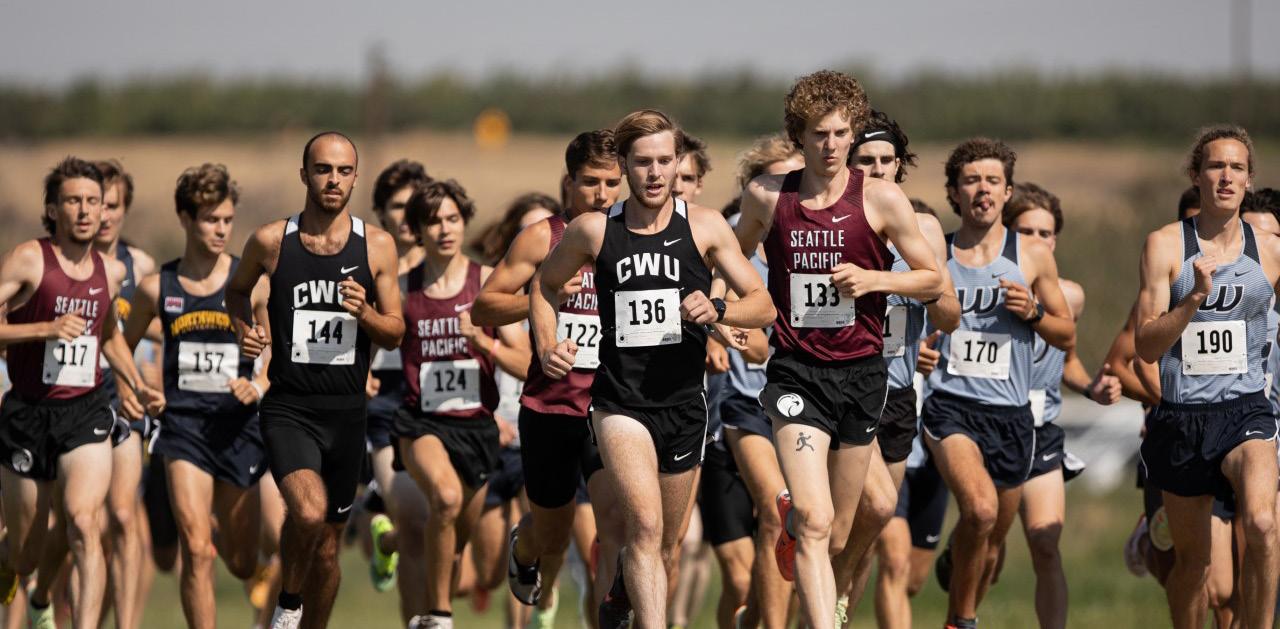
Kevin Adkisson, head cross-coun try coach, said that the NCAA Cross-Country Championship is important to all the participating teams because that is where they se lect the teams to go to nationals.
“Every team that’s on the west coast can participate in this event,” Adkisson said. “Overall, the cham pionship serves as our big finishing meet of the season and shows the training the cross country team did for this season.”
Senior runner, Ty Savely said that the regional meet is really spe cial to everyone.
“It’s going to be my last ever cross-country race,” Savely said. “We get to travel and run against teams that we haven’t run against before. It’s just a good way to end the season on a good note.”
Adkisson said there are numer ous goals that the cross-country team is working on as they partic ipate in the races.
“We usually try [to] set our
sights on the conference schools,” Adkisson said. “We liked to move up within the conference a team or two. We’d love to be in the top 20 since it shows we’re competitive and right in the thick of it with other schools.”
According to Adkisson, the top runners for this year’s men’s cross-country team are Savely, Shauwn Clough, and Jack Pratra pas. On the women’s team, Zoie
“If we can get all our top runners to have a good day, then maybe they can get new personal records,” Adkisson said.
Preparation for the race, accord ing to Adkisson, requires runners to focus on their own race plans. He also said runners that get too excit ed and start out too fast are going to fade.
“We want to be the ones who start out and run a smart race,” Ad kisson said. “Then really build on our effort and go get those other
people who weren’t so careful and smart. What we’re shooting for is really helping people focus on their own races but [also] working to gether with their teammates wher ever they can and being ready to sacrifice for each other.”
Rose Melville, junior runner, said that she learned this season to build on the mental aspect of running “I’ve not been performing exact ly the way I’ve wanted to,” Melville said. “I’ve been really surprised about how much I can rely on the
community of running and the community of my team.”
Adkisson said that the philosophy that he instills on the cross-country team is to be mentally positive.
“Running your best race requires a positive effort throughout the race,” Adkisson said. “Have a great outlook about the race the whole day, and the ability to build on your effort.”
Adkisson said that the regional meet is not just the last meet of the season but it is where everyone is trying to run their best race.
Breaking down Julio Rodriguez’s historic season
the award posted by the Mariners. “You only have one chance to do that in your career.”
After cementing himself as the Seattle Mariners best player during the year that they made the playoffs for the first time in two decades, outfielder (OF) Ju lio Rodriguez has been awarded American League (AL) Rookie of
Rodriguez became the fifth Mariner of all-time to win Rook ie of the Year, joining Alvin Davis (1984), Kazuhiro Sasaki (2000), Ichiro Suzuki (2001) and Kyle
The Dominican Republic-born phenomenon beat out Cleve land Guardians OF Steven Kwan and Baltimore Orioles catcher Adley Rutschman for the award, receiving 29 out of 30 possible first-place votes.
“It’s pretty cool,” Rodriguez said in a video of him react ing to winning
Rodriguez became the first play er in history to have 25 home runs and 25 stolen bases in their debut season. He reached those numbers at the fastest pace in history, doing so in 125 games.
Mariners President of Baseball Operations Jerry Dipoto thought that Rodriguez could have reached 30 home runs and 30 stolen bases, had he not missed games in the second half of the season.
“If he didn’t have a couple of set backs physically, the 30-30 thing would’ve been a reality,” Dipoto said to the Seattle Times. “He had a remarkable year. He accepts ev ery challenge, and then when the lights get brighter, he seems to shine even more.”
Rodriguez’s historic season in cluded an appearance on the AL All-Star team, the only rookie to be named an All-Star last season, as well as a Silver Slugger award, marking him as the best offensive
player at his position in the AL.
Rodriguez posted a season of 84 runs scored, 25 doubles, three triples, 28 home runs and 75 runsbatted-in (RBI).
On top of all of that, Rodriguez participated in the Home Run Derby at All-Star weekend, post ing a derby-high 81 homers, but ultimately losing to San Diego Padres superstar Juan Soto in the final round.

Rodriguez’s heroics culmi nated in the Mariners offer ing him the deal of a lifetime: $210 million guaranteed for 14 more years of his service, with the possibility of maxing out at $470 million if he reaches cer tain benchmarks (MVPs, cham pionships, etc.).
“What can I say? I’m just happy to be a Mariner,” said Rodriguez in the press-conference after he signed the extension. “I love being here. I love being with everybody, and I love to keep representing this city and bring a championship, that’s what we want here.”
November 22, 2022 SPORTS Page 10 @CWUObserver CWU Observer @CWUObserver cwuobserver@gmail.com cwuobserver.com
AppleRidgemeet. Photo by Jacob Thompson/Thompson Photos
Julioswingingfortheball. Photo courtesy of Alika Jenner/AFP
Ellensburg High School students sign to continue athletic career
Portland Trail Blazers fall against Brooklyn Nets
Professional basketball is back and in the thick of their season, recently the Portland Trail Blaz ers took a fall against the Brook lyn Nets in a close game.
The Blazers are 10-5 so far this season, including last night’s loss to the Nets, making the Nets 7-9. The game between the two NBA teams was a close one. The Nets took the win with a final score of 109-107. Nets forward Royce O’Neale scored on a tip-in with 0.7 seconds giving them the lead.
According to the ESPN web site, Blazers point guard Dami an Lillard had 25 points and 11 assists. The team averaged 38.7% for shots made and attempted, 29% of those shots were in the second half.
“We never really got a flow in the fourth quarter,” said Blazers coach Chauncey Billups in the postgame press conference.
“The end of the third quarter
really hurt us,” said Coach Bil lups. ”We had an 11 point lead with 2:40 to go, [Brooklyn] went on a 14-0 run that turned the tide on us. From there we were in scramble mode.”
With the Blazers trying to catch up, they soon began fouling Nets point guard Ben Simmons; he went three out of four on the free throw line, Nets preserving a 103-99 lead. Nets forward Kev in Durant then went to the line making it 106-103 lead.
Blazers center Jusuf Nurkic was fouled by Durant on a layup with 6.5 seconds left on the clock. Nurkic turned that around on a three point play and made it a tied game at 107-107.
Durant missing an off-balance fadeaway shot and O’Neale put ting it back up with only seconds on the clock ended the game with a win for the Nets.
Trail Blazers games can be found on Root Sports, either on cable or on FuboTV, DirecT VStream and Evoca TV.
Hixssen Sports Editor
Two Ellensburg High School (EHS) students signed their Na tional Letters of Intent (NLI) on Nov. 10 to continue their edu cation and athletic careers in El lensburg at CWU: Rylee Leish man and Joshua Boast Leishman, senior at EHS and
CWU women’s basketball com mit, said, “It’s just something that I have prayed about … [CWU] is where I want to go.”
Leishman plays guard for EHS and assisted the team to a state championship in March.
Another CWU commit, Boast, signed to continue his running career on CWU’s track and field team.
Boast is a versatile track ath lete, participating in multiple events including the 110m high hurdles, triple jump, long jump and the 4x100; this spring sea son Boast also expects to run the 300m hurdles.

“I initially started in seventh grade … From there I kind of just excelled,” Boast said.
These athletes have been rep resenting Ellensburg the last four years through EHS, now they get to identify under the town’s only university.
“I have built relationships with people of the community, where being able to play in front of them for another four years is truly amazing,” Leishman said.
According to Leishman and Boast, they both expected to go to college outside of Ellensburg, but when opportunities arose, they could not deny them.
“I’ve always wanted to go out of town and see other places …
but Central was automatically on my list,” Boast said.
Leishman said, “In the beginning I was like, ‘No, I want to go out of state or at least out of my home town.’ I wanted something new.”
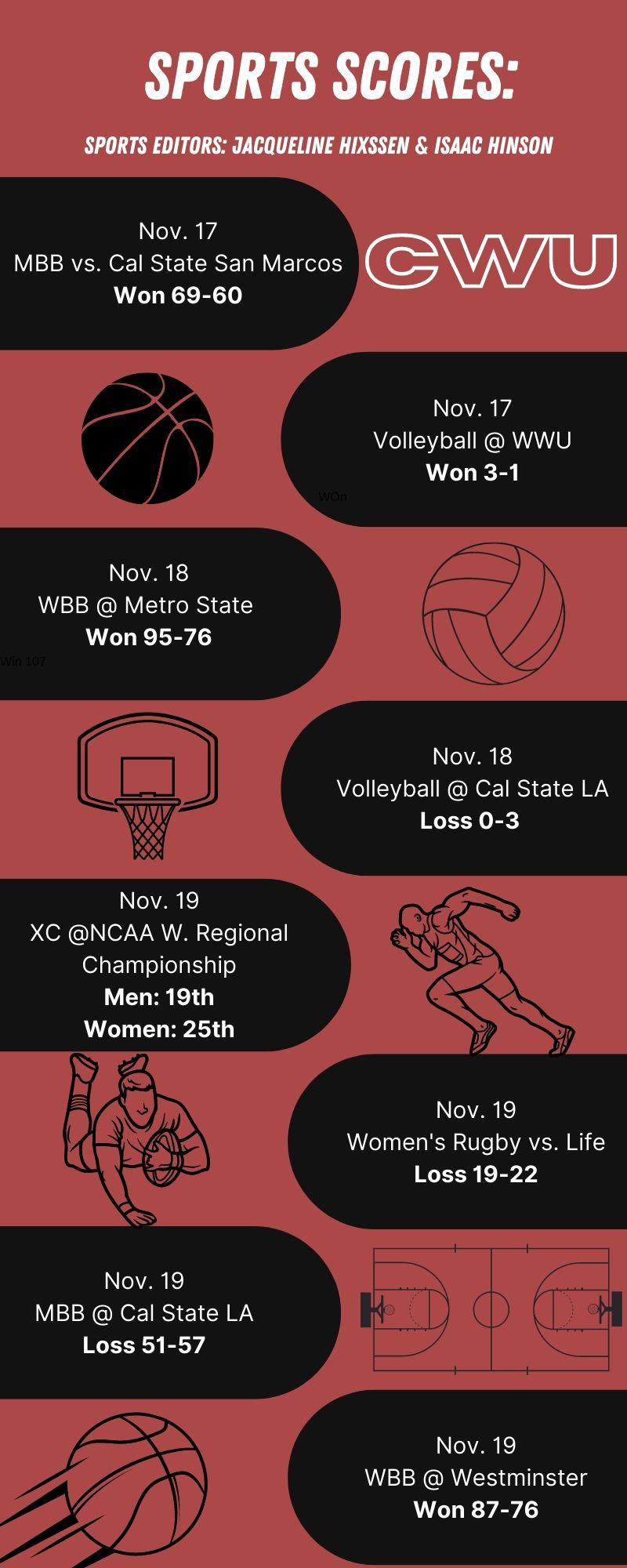
According to Leishman, it wasn’t until she traveled out of state for a basketball tourna ment that she realized she want ed to stay in Ellensburg and at tend CWU.
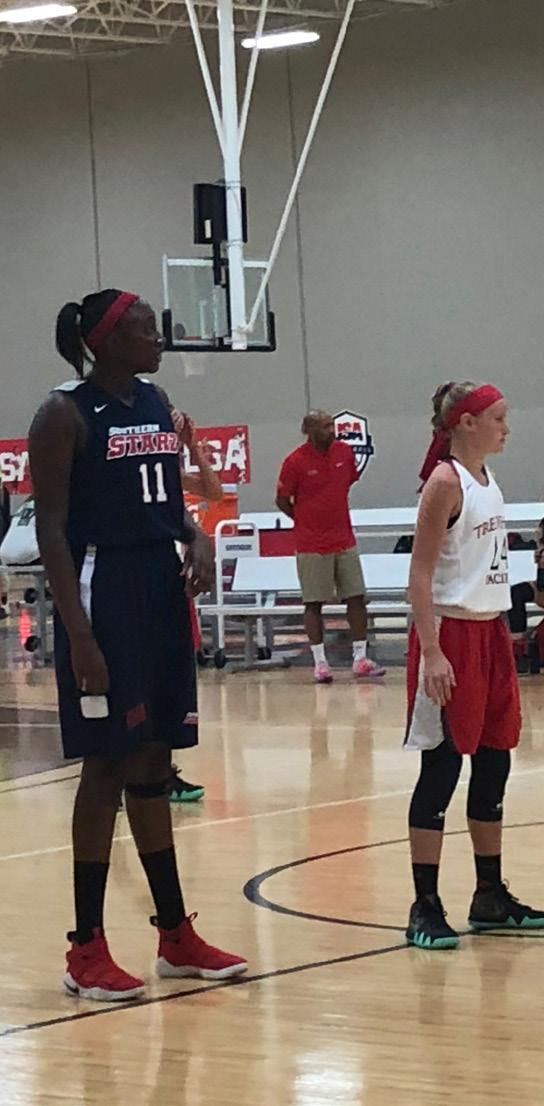
“I was in Ohio for a basketball tournament with my mom and just all of a sudden I was like ‘I can’t leave, I can’t imagine not having my family at every game,’” Leishman said.
Boast, being a triathlete in track and field, football and bas ketball, said he didn’t expect to continue running throughout college until the end of his ju nior season.
“I didn’t see myself running track until last year because I went to state last year for the first time so I was like, ‘Dang I gotta start looking for places to run for,’” Boast said.
Boast and Leishman will be graduating from EHS this upcoming spring. Leishman prepares to enter CWU’s ele mentary education program, while Boast’s choice is a toss up between sports medicine and aviation.
November 22, 2022 SPORTS Page 11 @CWUObserver CWU Observer @CWUObserver cwuobserver@gmail.com cwuobserver.com
Jacqueline
JoshBoastglidingoverthehurdleforEllensburgduring110mhighhurdles.
Photo courtesy of Josh Boast
RyleeLeishman(right).
Photo courtesy of Rylee Leishman
Devin Guerra-Burnett Staff Reporter
What first got you interested in flying, and what kept you interested? My dad’s a pilot for UPS so I just kind of grew up around aviation. It was just an area that I’ve always kind of found myself in. When I was a kid, I really tried to follow in my dad’s footsteps in pretty much everything I did. As I got older, I got to kind of see the benefits of the industry, and I got to fly around a couple times and really found out that I had a passion for it.
What is your favorite part about working as a certified flight instructor for CWU? It’s pretty rewarding seeing students succeed, especially if they go through some rough patches, to be able to kind of figure out what’s going to work for that student and help them succeed, and then kind of watch those a-ha moments, as they succeed in areas that they might have struggled with in the past is super exciting, as well as helping students just achieve their dreams. Aviation is a very expensive industry, and so a lot of the students that come into the industry, this is something they wanted to do their entire life and they’re very passionate about it. So to help them get to the point where they’re excited about advancing is pretty cool as an instructor.
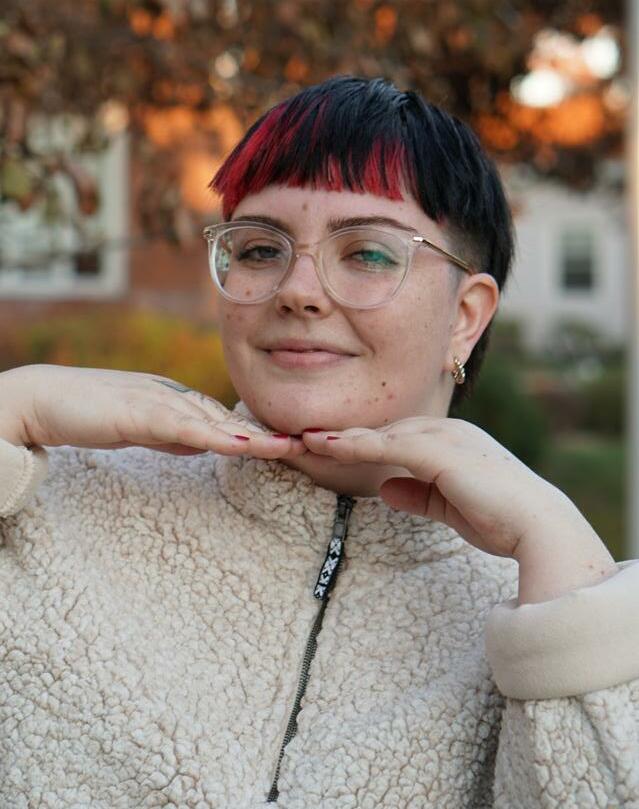


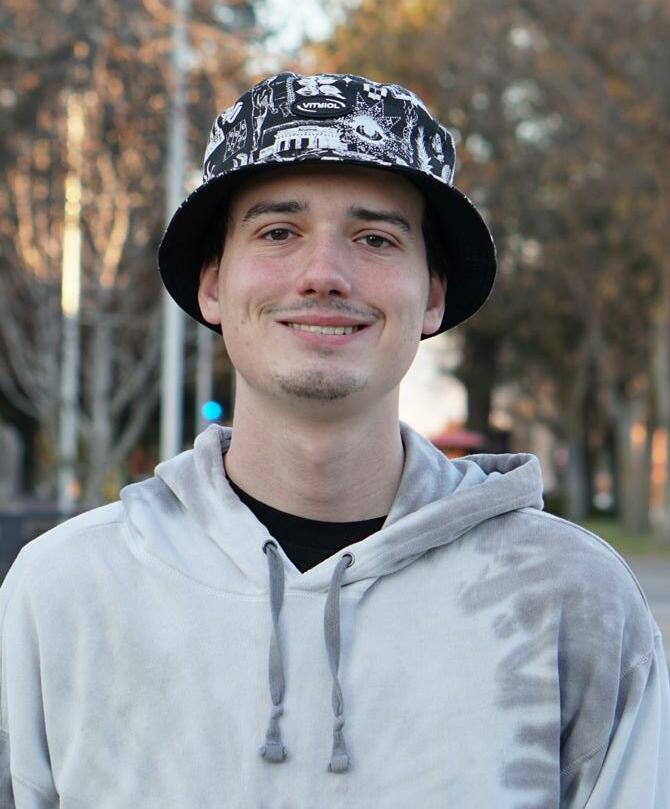
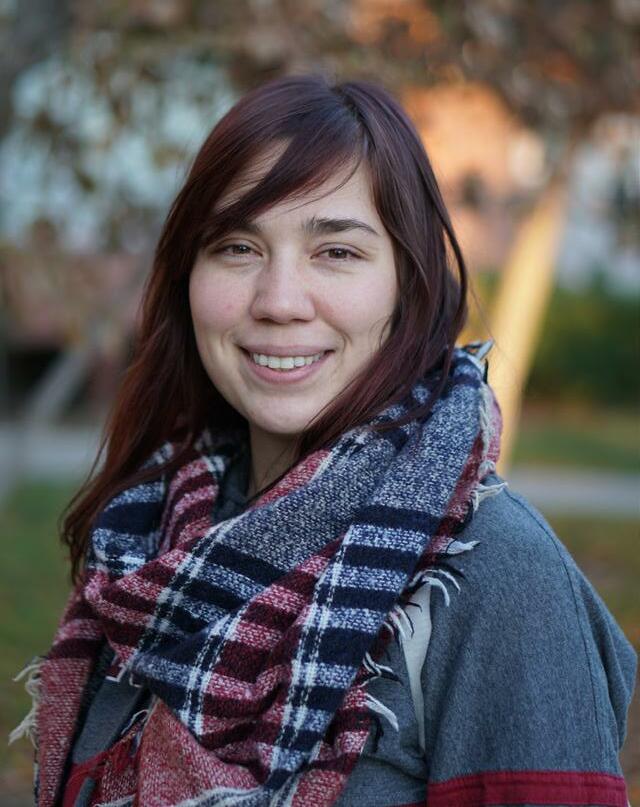
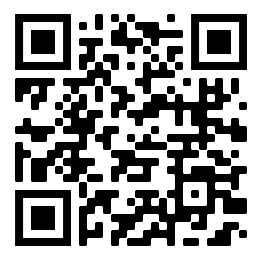
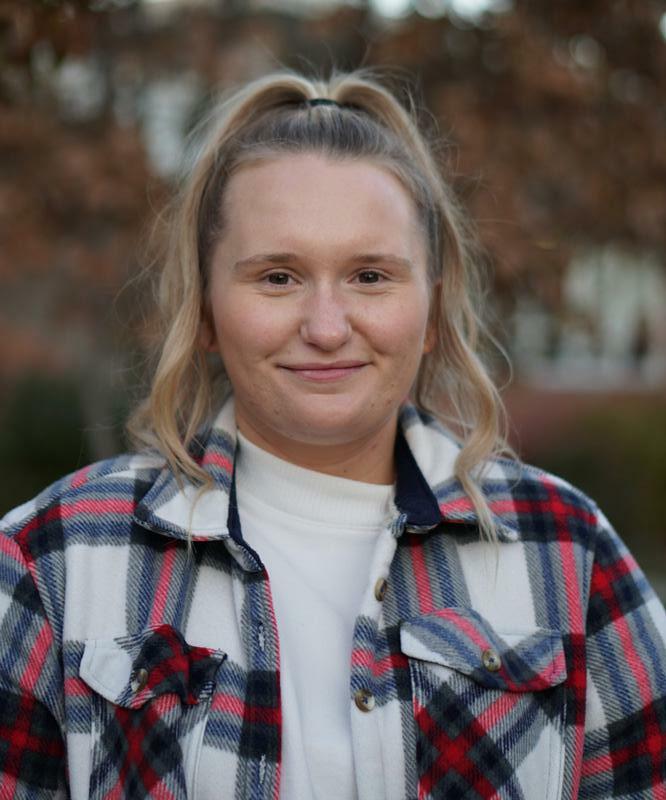

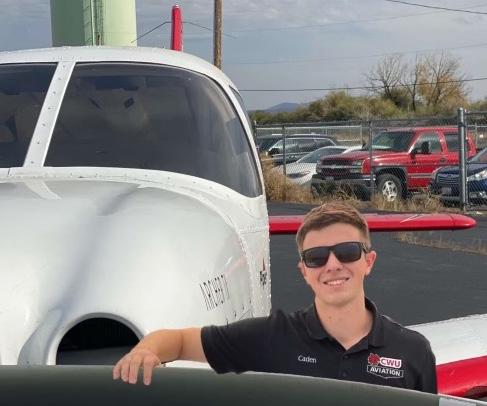
How is the aviation program different from the perspective of a student in the program versus an instructor in the program?
It’s not as different as I thought it was going to be going through the program, you really get to kind of learn the ins and outs of the industry. I think probably the biggest thing is just forming connections with people that are flight instructors, or with all your students and all the different per spectives that people have on why they’re becoming a pilot. As an instructor, you get a way better opportunity to see all the reasons people got into aviation, which is pretty cool.
What is your favorite type of plane and why?
I’ll probably have to go with the F-15. I want to fly in the National Guard when I grow up, when I get a little bit older, I guess. So the F-15 is kind of my dream plane and I hope I get to fly it someday.
What did it feel like during your first time solo flying?
Oh, man, it’s a crazy experience. It’s one of those experiences where you show up and you’re kind of nervous and like, ‘Man, I don’t know if I feel ready for this.’ And then you hop in the airplane and as soon as you turn that key and the prop starts moving, you just feel right at home. As soon as I took off, I remember being like, ‘Holy cow, this airplane feels really light.” You can tell a pretty big difference when somebody’s sitting in the seat next to you versus when you’re in the airplane alone. It’s one of those experiences where right away, you’re like, ‘Holy cow, I’m flying this thing alone, and nobody’s here for me.’ It’s a really exciting feeling for sure. It’s super free as well.
November 22, 2022 EVENTS Page 12 @CWUObserver CWU Observer @CWUObserver cwuobserver@gmail.com cwuobserver.com
Grad. Graphic Design “Canned cranberry sauce because it is so…canned.”
Sam Lee
Kyla White Grad. Marketing Management
“I’m going to say cranberry sauce. It is not even homemade most of the time. Why is that special, you know?”
Grad.
and Management “I hate gravy. It is disgusting and I have never liked it.” Peter Gard Fr. Undecided “I’m going to say stuffing. See all of the thanksgiving foods are great, but if I had to choose the worst one out of all of them it would have to be stuffing.” ““Stuffing. It just kind of is…not good.” Wildcat Words: What is the worst Thanksgiving food? National Pickle Day 7-8 p.m. Composition Studio Recital @ McIntyre Hall 174 10-11 p.m. Improv Night The Hot New Jam @ SURC Theater 210 28 MON 29 TUES weekly events Native American Heritage Thanksgiving Turtle Adoption Day 7 - 9 p.m. Open Mic @ Old 7:30 p.m. Monday Movie Mad ness - Elvis in SURC Theater International Day of Solidarity with the Palestinian People Vegan Potluck @ Hal Holmes Center Submit a letter to the editor or a guest column on our website! National Eat a Cranberry Day Q&A Q&A Q
Alana Jacobs Grad. Graphic Design
Megan Henderson
Leadership
&Acompiled
byKatherineCamarataandJacquelineHixssen.WildcatWordscompiledbyBrevinRoss.
Caden Merrill
CWU alumni in aviation program, CWU Certified Flight Instructor
 Katherine Camarata Lead Editor
Katherine Camarata Lead Editor


























 Andrew Ulstad Columnist
Andrew Ulstad Columnist















